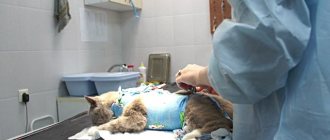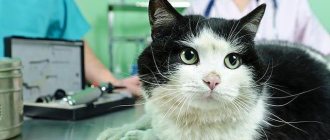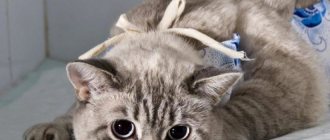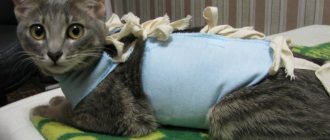If you are about to have your cat sterilized, remember: your attending physician should tell you about post-operative care. First of all, you need to follow his instructions and ask the clinic in as much detail as possible.
Why then is this article needed? The fact is that there are situations when an operated cat in a blanket is simply handed over to the owners without a full consultation. It happens that we’ve discussed everything, but forgot some small detail - but you can’t get through to the doctor because his working hours are over. And finally, some owners want to know in advance what kind of care the cat will need after surgery. Just to assess your strength and plan everything.
Post-operative appointments can vary greatly depending on how the surgery went, what anesthesia was used, and even your surgeon's personal habits and experience. In my article I will discuss general points that in no way replace a face-to-face consultation.
How long does it take for a cat to wear off anesthesia after sterilization?
The cat's condition after surgery varies greatly depending on the type of anesthesia. After inhalation (gas) anesthesia, the pet is returned to its owners in full consciousness. Cats recover very quickly after intravenous administration of propofol. It takes them about half an hour to wake up. Therefore, in this section I will talk mainly about intramuscular anesthesia. Usually this is a combination of a muscle relaxant (xylazine/domitor and their analogues) and zoletil. Some doctors use a drug that takes the cat out of medicated sleep. Antisedan removes the domitor effect, and the animal can walk within 30 minutes after the injection.
Cat after sterilization using intramuscular anesthesia
Not all experts yet have an anti-sedan available. Some people simply save money on it (“and so it will wake up”). Others follow the lead of the owners, who find it more convenient to take home a “rag” rather than a meowing cat that is trying to get out of the carrier. All this is unacceptable!
Find out in advance what kind of anesthesia your cat will be given. If after sterilization she is unconscious, it is better to leave her in the hospital under observation for several hours.
Not every clinic has equipment for inhalation anesthesia.
At what age are cats spayed?
Veterinarians recommend sterilizing pets after at least 7-8 months have passed since birth. Early surgery for a kitten is highly undesirable, the body is not yet mature, the internal organs are not fully formed, which is why the risks of complications increase many times over. Experts note a lag in physical development in animals that underwent surgery at the age of 6 months or younger, which is due to strong changes in the proportions of hormones.
Older kittens (more than 8-9 months from birth) are also sterilized, but it should be remembered that the older the pet, the higher the risk of complications after surgery on the cardiovascular and excretory systems of the animal’s body. This happens due to exposure to anesthetic vapors. They are much more toxic to animals than to humans. When to sterilize a cat is up to the owner, but you should listen to the opinion of experts. If she is already pregnant, the operation can be performed at any stage.
How to help your cat recover from anesthesia
Let's consider a situation in which you were given a cat under deep anesthesia. She already twitches her ear if you blow into it, but she can’t blink or walk yet. Paws and ears are cold to the touch. This is due to the fact that body temperature during anesthesia decreases by several degrees. Unfortunately, not all doctors use a heating pad during surgery. Therefore, the cat may experience noticeable trembling - it is simply very cold. And the animal needs to be warmed.
If the cat's eyes are open and she is not blinking, then care should be taken to moisturize the cornea. It’s easier to apply tetracycline ointment and “glue” the eyelids together. Cornergel is well suited for moisturizing. You can drip regular saline solution. Often veterinarians will apply eye ointment themselves during surgery, ask your doctor about this. Owners of brachycephalic dogs (Persians, exotics) should be especially attentive. Their bulging eyes are prone to drying out and causing keratitis.
Cats do not close their eyes while under anesthesia
If you hold a cat in your arms, it should lie belly down. One hand under the chest, the other under the butt. To prevent the tongue from sticking and blocking the airway, it is pulled out of the mouth to the side. When the cat is able to retract it on her own, she will do it. Before this, you can gently moisten the tongue with water so that it does not dry out.
Even if the cat was on a fasting diet before surgery, it may vomit during recovery from anesthesia. To prevent her from choking, her head should be turned to one side or hang down freely. You cannot cradle your pet in your arms like a baby doll (back down).
At home, the cat should be placed on its side, in a warm place on the floor (a blanket near the radiator). It is strictly forbidden to place a sleeping cat on a bed or sofa. On the bed - only when the animal can climb there on its own. The cat may not understand where it is and fall awkwardly down.
If the cat was “packed” into a carrier at the clinic, then it is best to leave it there. Place it on the floor and open the door so that your pet can come out whenever she wants.
The carrier should be spacious and rigid, not fabric
How does a cat behave after anesthesia?
When the cat starts to get up, it may stagger like a drunk and crash into walls and objects. There is no point in holding her in place by force. It is better to limit your pet's movements within one room.
In order for the cat to calmly come to its senses, you need to remove external stimuli as much as possible. When recovering from anesthesia, even the calmest cat can become aggressive or panic. Need to exclude:
- Society of other animals;
- Loud, sharp sounds;
- The light is too bright;
- Drafts, cold;
- Violence in any form (being held in arms, dragged from place to place).
When waking up, the cat does not understand well what is happening around. She feels weak (her legs can't hold her up, her head is spinning). Instinctively, the animal will try to defend itself or run away - just in case. Do not allow children to pet your pet when she recovers from anesthesia, and be careful yourself. Without recognizing your hands, the seemingly sleeping beauty can rise up like a candle and awkwardly fall back.
Sometimes owners are frightened by the vocal exercises of a cat that is just waking up from anesthesia. This may be a hoarse meow, a howling growl or hissing.
Residual effects from anesthesia may last up to a day (usually much less), after which the cat will behave as usual. A short video showing a cat after anesthesia:
When can you feed a cat after sterilization?
The sterilization operation is preceded by an 8-10-hour fasting diet. Therefore, when everything is over, the owners cannot wait to feed their pet. However, there is no need to rush: after anesthesia, vomiting is possible.
The doctor should tell you how many hours after sterilization you can feed your cat. Recommendations will vary depending on the type of anesthesia used during surgery. On average, you can offer food through:
- Inhalation anesthesia – 1-2 hours;
- Intravenous anesthesia with propofol - after 2-3 hours;
- Intramuscular anesthesia (Domitor + Zoletil) – after 4-8 hours.
What to feed a cat after sterilization and anesthesia
The main mistake of loving owners is the desire to pamper an operated cat with something special. A sudden change in diet can cause digestive upset. There is no need to feed your cat differently after sterilization than before surgery.
If the kitty ate natural food, then the only recommendation is to give the food warm, and not from the refrigerator. You should also avoid products that are strong.
If the cat has been eating dry food, then it is offered when the animal comes to its senses after anesthesia. There is no need to soak the food: the cat had her ovaries removed, not her teeth. However, in addition to crackers, owners often regularly provide canned food from the same company. Then wet food will be an ideal option.
There is no need to run to buy food for sterilized cats immediately after surgery. Hormonal levels will change gradually over 1-2 months. You need to switch to a new food smoothly, after the blanket is removed and the cat has fully recovered.
After sterilization, cats tend to become overweight, but hormonal changes take time
Benefits of sterilization
- Lack of physical discomfort in the cat during the period of heat;
- Prevention of the appearance of tumors of the mammary glands, ovaries, uterus and purulent pyometra;
- Solving the problem of unwanted offspring;
- Improvement of the animal's character, disappearance of aggression;
- Lack of sexual behavior towards foreign objects;
- Eliminating the risk of developing tumors and inflammation of the animal’s reproductive organs;
- Effective prevention of genitourinary diseases in cats;
- Atrophy of the animal instinct of “vagrancy”;
- Maximum pet domestication.
How long to wear a blanket after sterilizing a cat
The main condition after sterilization is to prevent the cat from licking the seam. To do this, use either an Elizabethan collar or a fabric blanket. The duration of wearing these “accessories” depends on what kind of stitch was applied. You need to focus on the recommendations of the operating surgeon and the condition of the suture, because healing in different animals can occur at different speeds.
If a cosmetic suture was applied (absorbable threads are all inside, the skin is perfectly connected end-to-end), then the blanket is worn for about a week (7 days). I am a reinsurer, so I recommend wearing a blanket for 10 days after surgery.
This is what a cosmetic seam looks like after sterilizing a cat. All the threads are inside.
If the seams are removable, then the blanket is worn until the seams are removed, plus one day after, so that the holes heal quietly after the threads are removed. Usually it is 10-12 days.
This is what a cosmetic stitch looks like on days 10-12
On the first day after surgery, the cat shows little interest in the suture. The worst concern is on the 3-4th day: the shaved fur begins to grow back, and the healing seam begins to itch. The cat may try to lick its tummy through the fabric.
Some cats calmly accept the “clothes” and do not try to take them off. Others roll around and tear at it with teeth and claws until they get rid of it. In this case, it is preferable to wear a collar instead of or together with a blanket.
Instead of blankets, you can wear more beautiful clothes
When a cat first wakes up after surgery, it may back away or walk backwards. Or she completely refuses to get up and walk, as if paralyzed. As soon as you remove the blanket, these frightening symptoms disappear. Check that the blanket is not tied too tightly, and the cat will soon get used to it.
Cats hate blankets, but you have to be patient
How to treat a seam after sterilizing a cat
Modern standards of veterinary medicine do not require any suture treatment after sterilization of a cat. The tiny cosmetic suture heals on its own; it is not even necessary to remove the blanket within a week after the operation. In the clinic, as a rule, a special spray is applied to the seam and shaved belly:
- Dark gray leather - it was Aluminum spray (Alu-spray, Second Skin);
- Bright green – Terramycin spray;
- Purple – Chemi spray.
The surgical field and suture are treated with Aluminum spray
The seam should be processed only if it is external and removable - the thread knots are visible. And only if the treatments were prescribed by your surgeon. The point is to prevent the threads from sticking to the skin and to each other. Good non-aggressive antiseptics are aqueous Chlorhexidine 0.05% or Miramistin. Using a cotton pad soaked in the solution, carefully remove all crusts and discharge and separate the threads. It is enough to treat once a day. Be sure to remove any stuck-on hair that accumulates in the seam area.
This is what the outer seams look like. Even if absorbable material is used, it is better to remove the threads on the 12th day
Do not use alcohol or drying solutions – Fukortsin, brilliant green – to treat seams. Iodine - only diluted with water 1:1. You should not use any ointments; the seam should be clean and dry.
Removable sutures are removed at 10-12 days. This is a painless and quick procedure. After removing the stitches, the doctor will once again treat the skin with an antiseptic spray and put on a blanket. You can take off your clothes the next day.
Sterilization price
The answer to the question of how much sterilization costs will depend on the veterinary clinic where the procedure is supposed to be carried out, the method and type of operation, the presence of concomitant pathologies, the quantity and specificity of medical consumables and medications. Additional costs cannot be ruled out either. More detailed information about the cost and nuances of castration can be obtained directly from the clinic during a consultation with a doctor.
Treatment after cat sterilization
If a young and healthy cat was operated on, then no drug treatment is required after sterilization. On the day of surgery, the doctor gives a single injection of a long-acting antibiotic and pain reliever.
If maximum sterility is maintained after surgery, antibiotics are not needed. A clean room, careful preparation of the animal, high-quality consumables - only under such conditions can the doctor not fear a suture infection.
When it comes to pain relief, veterinarians may have different opinions. The vast majority do not consider it necessary to prescribe analgesics. This is due to the small size of the suture on the abdominal wall. Abroad, such medications are prescribed for 3-5 days after surgery.
If your cat wears a collar, you don't need to wear a blanket.
If your doctor considers the use of antibiotics or analgesics necessary, follow his instructions! Only he knows how the operation went, what condition the uterus was in and other nuances. Intensive treatment is prescribed to cats in case of pyometra (purulent inflammation of the uterus); this operation cannot be equated to sterilization of a healthy cat.
What to do if the cat removed the stitches on its own
Early removal of sutures is fraught with inflammation and even loss of internal organs from the peritoneum. Make sure that the blanket completely covers the operated area and do not allow the animal to lick the seam.
If, however, the cat removes the threads on its own, take it to the surgeon who performed the operation as soon as possible to evaluate the condition of the incision. If the picture is unsatisfactory, the stitches will need to be re-stitched.
All information posted on the site is provided in accordance with the User Agreement and is not a direct instruction to action. We strongly recommend that before using any product, you must obtain a face-to-face consultation at an accredited veterinary clinic.
Sterilization of a cat: care after surgery “in a nutshell”
The Internet is full of articles that present sterilization surgery in cats as a global event. “After sterilization, a cat needs careful care,” “it’s better to take a vacation to look after your pet,” “you’re not castrating a cat, it’s a abdominal operation,” and so on and so forth.
I think this approach is not entirely justified. In modern veterinary medicine, sterilizing a cat is a routine procedure, and no care for the pet is required. They brought him home, fed him, and for a week he walks around in a blanket or collar. All.
I will duplicate the main recommendations in the postoperative period:
- While the cat is recovering from anesthesia, it needs to be provided with warmth and peace.
- Feed a small amount of the usual food, when the obvious signs of “insanity” pass, the next day feed as usual.
- Do not allow the seam to lick until complete healing (about 10 days), wear a blanket or collar without removing it.
Is it possible to spay a cat during heat?
The operation is carried out during the hunting period, but the postoperative period, wound healing, and recovery of the pet can be significantly delayed. If the operation is performed during estrus, then a very sharp change in hormonal levels occurs in the body. Without urgent need, veterinarians do not recommend sterilizing pets during this period. The optimal time for the procedure is two weeks before the start of estrus or a week after its end. Sterilization of cats during pregnancy is also undesirable.
Is it necessary to treat a cat's suture after sterilization?
Most inexperienced owners are guided by logic and begin to treat the seam after sterilization, despite the doctor’s recommendations. As a result, the seam begins to get wet and takes longer to heal. When should a seam be processed and when not?
Sterilization of a cat is an abdominal operation, during which the surgeon cuts the wall of the peritoneum. If no difficulties arise during the operation, the suture width is 2–3 cm. Most surgeons close the incision with intradermal sutures. As a result, the seam looks like wrapped, glued leather (no threads are visible or only the edges are visible).
Normally, after suturing the wound and treating it with an antiseptic, the seam should remain dry. Statistics show that the following complications are possible:
- 15% – swelling and redness of the suture.
- 10% – allergic reaction to suture material with its subsequent rejection.
- 30% – damage to the seam by a cat.
If your pet does not have any complications, the suture remains dry, does not redden or swell, no treatment is needed. Strictly follow the surgeon's recommendations, make sure that the cat wears a blanket or Elizabethan collar.
Note! Self-injury (separation of threads and ligatures, suture unraveling) is the most common complication. In the first few days after surgery, the cat feels skin tightness. When the stitch begins to heal, the cat begins to experience itching.
Meaning of sterilization
There can be several reasons for removing an animal’s reproductive organs, from ethical to medical. Despite alternative modern means of combating periodic “cat walking” in the form of various hormonal drugs, tablets and drops, many cat owners still choose sterilization . This method allows not only to regulate the appearance of unwanted offspring, but also to literally preserve the health of your animal. The procedure for carrying out such operations today does not pose any danger or difficulty and has long been considered routine in veterinary medicine.
Most often, sterilization is used in the following cases:
- keeping an animal at home with complete absence or partial access to the street in order to prevent unplanned birth of offspring;
- the presence of pathological processes in the genitourinary and gynecological areas;
- in order to prevent the development of diseases of the reproductive system in old age - tumors, infections, cysts or cancer;
- reluctance to “add” the animal to hormonal and chemical drugs that suppress sexual desire.
Contrary to the prevailing public opinion regarding the harm of sterilization for the health of cats, it should be noted that individuals who have undergone this manipulation have strong immunity and a healthy psyche. The animal fully retains its inherent temperament and behavioral qualities. “Neutralization” of the hormonal functioning of the gonads does not in any way affect the character and mental development of the animal. The only changes that take place are the animal’s lack of aggression. After surgery, a cat behaves more calmly, they are affectionate and gentle. It has been noted that it is among castrated animals that the highest percentage of long-livers is found.
How to treat the seam after sterilization?
How to treat the seam, if necessary? The prescription of drugs directly depends on the situation:
- In case of redness and swelling, it is necessary to remove the crusts with chlorhexidine, treat the scar with levomekol and one of the drugs that improve tissue regeneration.
- If the cat has an allergic reaction, antihistamine therapy is prescribed. Rejection of suture material often leads to suture dehiscence, so depending on the situation, the suture may need to be treated or reapplied.
- If the cat has damaged the suture, it is re-sutured and preventive treatment is prescribed - chlorhexidine, an antiseptic and regenerating agent.
If the first symptoms of redness and swelling are missed, the suture may fester. In this case, fluid begins to collect right under the skin, and then pus. If the seam was closed “tightly” (without drainage), the liquid will accumulate until the skin breaks.
If suppuration occurs, you must contact a veterinarian, who will make a small hole in the seam and install drainage. To stop inflammation, non-steroidal drugs, antibiotics and suture treatment are usually prescribed.
The seam is processed:
- Antiseptic drugs.
- In case of severe suppuration, tightening ointments are prescribed, for example, Vishnevsky ointment.
- In case of severe swelling, compresses with dimexide are prescribed.
Note! The cat must wear a blanket throughout the entire treatment period, otherwise it will lick the ointments.
The basic principles for rapid healing of a seam are dryness and cleanliness. Make sure that no dried fragments of effusion and pus remain on the skin. Use only clean sponges to clean the wound, using one at a time. Do not apply tight bandages and do not use adhesive tape. For skin to dry and heal, it must breathe.
Do I need to remove stitches at all?
Here everything depends on the characteristics of the suture material used during the operation. Today, veterinarians all over the world are trying to use varieties that dissolve on their own. But this doesn't always happen.
In addition, even material that is “digested” by the animal’s body is not immediately absorbed. The stitches left on the animal's skin are disturbing and irritating. Therefore, the cat will constantly itch and chew its belly. All this may well lead to the development of an inflammatory reaction.
Many veterinary specialists clearly answer that sutures should be removed regardless of the suture material used.
This will save you from many problems in the future. Please note that this only applies to external seams. Sutures placed on the peritoneum dissolve perfectly.
How and for how many days should I treat the suture after sterilization?
The duration of anti-inflammatory therapy is determined by the veterinarian. If you do not have the opportunity to see a doctor, the main thing is not to overdo it and stop treating the seam as soon as it dries.
Regular application of the ointment gives a disinfecting effect, but additionally moisturizes the skin. Almost all drugs that accelerate regeneration provoke the release of effusion (ichor, interstitial fluids).
Note! Most ointments containing antibiotics can be used for a limited time.
Read the instructions carefully; if it does not say how many days to treat damaged tissues, it is better to consult a veterinarian.
Let's figure out how to process a seam:
- Take the cat in your arms, pet it and calm it down.
- Remove the blanket and lay the pet on its side.
- Carefully inspect the seam for crusts and dried liquids (ichor, pus).
- Gently clean the wound with chlorhexidine.
Note! Chlorhexidine is used to soak crusts and dried biological fluids.
Soak the sponge well and apply it to the wound. Wait about a minute and carefully remove everything that has become wet (it comes off easily from the skin). Repeat if necessary.
- Distract your cat for a few minutes while the chlorhexidine dries.
- Only after the wound has dried, apply ointment.
- Try to distract the cat for as long as possible so that the ointment has time to be absorbed.
- Put a blanket on your pet as soon as he stops paying attention to you and starts licking the seam.
Tip: to process seams you must have a good view, so it is better to carry out the procedure on a table with good lighting.
If your pet is prescribed compresses with dimexide, proceed as follows:
- Prepare a clean piece of gauze.
- Place cotton wool in the compress and wrap it with gauze in at least two layers.
- Dilute dimexide with novocaine (usually a 1:1 ratio is prescribed).
- Soak the compress and apply it to the seam.
- To secure the compress, it is convenient to use compression nets on the arm or leg (sold in pharmacies).
- If a hermetic compress is prescribed, an oilcloth is placed over the mesh and secured with an adhesive plaster.
- Hold your cat in your arms or cover her with a blanket throughout the procedure.
- After 5–15 minutes (depending on the veterinarian’s prescription), the compress is removed.
After removing the compress, you need to “dry” the skin before putting on the blanket. Do not wet the seam to remove any residual dimexide. There is no harm in using antiseptic sprays, but we will talk about them below.
What to do if the cat does not allow the seam to be processed?
Many owners complain that the cat does not allow the seam to be processed, bites, breaks out or hides. Let’s immediately determine that the cat’s behavior is directly related to your emotions. If your pet behaves calmly with the veterinarian, but he throws a scandal at you, he is manipulating you.
If the situation has reached the point of absurdity and you cannot process the seam (and this is necessary) you have three alternatives:
- Take your pet to the veterinarian for dressings.
- Ask a stranger (for the cat) to handle the pet's seam.
- Use antiseptic sprays that do not require tactile contact.
If you have no one to turn to for help, your only option is veterinary antiseptic spray.
The drug can be purchased at a veterinary pharmacy. Treatment consists of spraying the wound with an antiseptic substance. The drug protects the seam and helps maintain the normal pH of the skin.
Depending on the purpose, the spray may contain silver or other disinfectants. Be sure to consult with your veterinarian before using medications, as many antiseptic sprays are very drying to the skin.
Sterilization of cats is the surgical removal of the gonads (tubal tightening or removal of the uterus), as a result of which the function of hormone production fades and sexual activity ceases. Sterilization is carried out in two cases: for medical reasons or at the request of the owner (so that the cat does not bear offspring). The duration of the operation lasts 0.5-1.5 hours, but postoperative care for the cat is also important.
Sterilization can be carried out both in the clinic and at home.
Hospital: to be or not to be?
To avoid unnecessary problems, some owners leave the animal in a hospital - of course, this will cost more, but the cat will be under the supervision of specialists, there is no need to take the pet home (especially in the cold season), the issue of independent care and responsibility for compliance are eliminated. all the rules. This technique also has disadvantages: firstly, you must be confident in the reputation of the veterinarian and, in fact, the clinic; secondly, for a cat, a change of environment, and even after surgery, is constant stress. Thirdly, the animal may be offended, considering this as inattention on your part.
Caring for a cat after sterilization at home
The animal can be given to you, even if the anesthesia has not yet worn off. Often he is dressed in a post-operative blanket, and if your four-legged friend shows aggression, it is better to put a protective collar on him - this will make it easier for you to handle the stitches, and the cat will not lick them. Ask your veterinarian if they gave you pain medication, and if not, when should you give the injection? Professional clinics provide clients with brochures with recommendations for caring for a pet. After the operation is completed, it is advisable to stay in the clinic for another 20-30 minutes to make sure that there is no bleeding from the suture.
It’s better not to take your cat on public transport, but to use a car or call a taxi - your pet is already stressed. Place your cat in a carrier: if it’s cold outside and you have a long commute, you can put a heating pad in the carrier. The animal should be on its side so that if vomiting occurs, it does not choke on the vomit.
After returning, place the cat on a soft bedding low from the ground, turning it from one side to the other every 30-40 minutes. The bed should be located away from drafts or a heater. Room temperature is quite enough: if your pet is shivering, you can cover it or place a heating pad nearby. Check for bleeding from the suture (small leaks of blood, as well as the discharge of watery ichor, are acceptable).
In 1-











